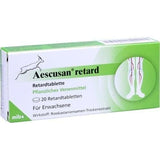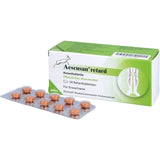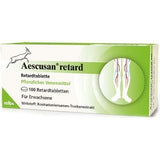AESCUSAN retard retard tablets, triterpene saponins, aescin, proanthocyanidins, horse chestnut tree
The ingredients come from the horse chestnut plant and act as a natural mixture. About the plant itself:
- Appearance: up to 30 m tall deciduous tree with large fingered leaves and showy pink flower spikes; the shiny brown seeds are surrounded by a yellowish-green prickly shell
- Occurrence: temperate zones
- Main ingredients: triterpene saponins (aescin), proanthocyanidins
- Plant parts and preparations used: mainly extracts and tinctures of leaves, flowers and seeds
Aescin has vascular-sealing and edema-inhibiting effects and improves vein tonification. The ingredients also have an anti-inflammatory effect.
Active substance: dry extract from horse chestnut seeds
AESCUSAN, triterpene saponins, aescin, proanthocyanidins, horse chestnut tree Composition:
1 prolonged-release tablet contains 263.2 mg dry extract from horse chestnut seeds (Aesculus hippocastanum L.) (drug: drug preparation 4.5 -5.5 : 1), adjusted to 50 mg triterpene glycosides, calculated as anhydrous aescin.
Excipients : calcium hydrogen phosphate, talc, magnesium stearate, dimethicone, hypromellose,
poly[ethyl acrylate-co-methyl methacrylate-co-(2-trimethylammonioethyl) methacrylate chloride]
(1:2:0.2), povidone, macrogol 4000, crospovidone, colloidal anhydrous silica, Polysorbate 80, Sodium Saccharin, Vanillin, Triethyl Citrate, Titanium Oxide, Iron Oxide.
AESCUSAN, triterpene saponins, aescin, proanthocyanidins, horse chestnut tree Application:
Symptoms of diseases of the leg veins (chronic venous insufficiency), such as pain and a feeling of heaviness in the legs, calf cramps, itching and leg swelling.
Side effects: Rarely irritation of the mucous membranes in the gastrointestinal tract, in isolated cases itching, nausea and stomach problems, in one case a serious allergic reaction.
Areas of application:
- Venous weakness, for supportive treatment Instructions for
use AESCUSAN, triterpene saponins, aescin, proanthocyanidins, horse chestnut tree:
The total dose should not be used without consulting a doctor or pharmacists are exceeded.
Type of application?
Take the medicine with liquid (e.g. 1 glass of water).
Duration of use?
The duration of use depends on the type of symptoms and/or the course of the disease. In principle, the duration of use is not limited in time, so the drug can be used for a longer period of time.
overdose?
Overdose can cause nausea, vomiting, and diarrhea, among other things. If you suspect an overdose, contact a doctor immediately.
Forgot to take?
Continue taking it as normal (i.e. not double the amount) at the next prescribed time.
In general, pay attention to a conscientious dosage, especially for infants, small children and the elderly. If in doubt, ask your doctor or pharmacist about any effects or precautions.
A dosage prescribed by the doctor may deviate from the information on the package leaflet. Therefore, since the doctor adjusts them individually, you should use the medicine according to his instructions.
Mode of action:
How does the ingredient in the drug work?
The ingredients come from the horse chestnut plant and act as a natural mixture. About the plant itself:
- Appearance: deciduous tree up to 30 m tall with large fingered leaves and showy pink flower spikes; the shiny brown seeds are surrounded by a yellowish-green prickly shell
- Occurrence: temperate zones
- Main ingredients: triterpene saponins (aescin), proanthocyanidins
- Plant parts and preparations used: mainly extracts and tinctures of leaves, flowers and seeds
Aescin has vascular-sealing and edema-inhibiting effects and improves vein tonification. The ingredients also have an anti-inflammatory effect.
Contraindications:
What speaks against an application?
- Hypersensitivity to the ingredients
Which age group should be considered?
- Children and adolescents under 18 years of age: There are no dosage information for this age group.
What about pregnancy and lactation?
- Pregnancy: There are no findings on this. If in doubt, seek advice from your doctor or pharmacist.
- Breast-feeding: Ask your doctor or pharmacist for advice on this, as there is no information available on this.
If you have been prescribed the drug despite a contraindication, talk to your doctor or pharmacist. The therapeutic benefit can be higher than the risk that the use entails in the event of a contraindication.
Side effects:
What side effects can occur?
Only side effects that have only occurred in exceptional cases so far are described for the drug.
If you notice any discomfort or changes during treatment, contact your doctor or pharmacist.
For the information at this point, side effects are primarily taken into account that occur in at least one in 1,000 patients treated.
Important information:
What should you consider?
- Be careful if you are allergic to the solvent polyethylene glycol (E number E 431)!
- Be careful if you are allergic to the solvent propylene glycol (E number E 477)!
- Be careful if you are allergic to the preservative sorbic acid (E number E 200, E 201, E 202, E 203)!
- Be careful if you are allergic to the sweetener saccharin (E number E 954) or to sulfonamides!
- Be careful if you are allergic to talc!
- Be careful if you are allergic to citric acid (e.g. in citrus fruits, currants, apples)!
- Be careful if you are allergic to phenol (e.g. pyrogallol, triclosan and vanillin)!
For medicines: Read the leaflet on the risks and side effects and ask your doctor or pharmacist.






